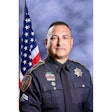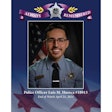Women have filled varied roles in law enforcement for nearly a century, yet only with the equal opportunity acts of the '60s and '70s did the numbers of female patrol officers rise noticeably. Subsequently, duty gear began to tentatively adapt to the needs of female officers.
Now, 40 years into full female participation in police careers, we have contoured duty belts, women's uniform trousers, boots that fit smaller, slimmer feet and perhaps of most importance, serviceable body armor that accommodates the female figure.
The efforts of body armor manufacturers to fit female officers have taken several directions. Some sew the front vest panel as if it were a closely tailored garment with at least two darts of carefully overlapped layers forming an angled distention in the vest's front panel.
Another method involves constructing a three-part front panel sewn to resemble a princess-style bodice. Other armor designers have moved toward materials that drape over the bust-line, eliminating the need to tailor the shape.
As the technology has changed, options and performance have increased. Let's take a look at features that increase vest wearability specifically for female officers.
Second Chance
The name Second Chance is synonymous with bullet resistant vests, since founder Richard Davis received the first patent on concealable body armor in the early 1970s. Much has changed since those first vests and continues to change even since 1993 when I received my first Second Chance vest.
Advances in materials make it unfair to compare that vest to the new Second Chance Ultima 9th generation vest! New materials, like Second Chance's proprietary Zyloflex, yield easier movement, unobstructed breathing, less chafing and better protection.
Second Chance's women's department was introduced in 1985 when the manufacturer began to incorporate darts into Second Chance's vests to accommodate female officers. "In the beginning, if we made 25 women's vests a month we were lucky," Second Chance's Linda Lockhart reminisced. "Now we usually average 200 a week."
Unlike the men's vests, all women's sizing is done in-house at Second Chance. "Three or four of us specialize in incorporating the measurements submitted to be sure the vest fits right," Lockhart explained. Over 15 years of experience helps this crew detect discrepancies before a vest is shipped. Second Chance continues with their time-proven front panel pattern with sewn-in side darts folded into the material so no cut is made in the protective panel's fabric. Their Double Dart system distributes the bulk by alternating the fold up then down from one layer to the next.
Technological advances in the garment holding the ballistic panels are also responsible for better comfort. The recently introduced Mac-X carrier has detachable side straps and full Velcro¨ adjustability that has worked exceptionally well for the challenge of forming body armor to the female torso.
Safariland
A completely different shaping method is found in stitchless conformation of the front vest panel, exemplified by Safariland's Zero-G Female vest. Instead of building each front panel to a particular "cup" size, Zero-G vests use Safariland's SmartForm ballistic panels that drape around the individual's shape. Seamless darts, as Safariland dubs the notches cut in the upper armhole of their female vest's front panel, encourage the panel to fold over the bust-line, adapting to varying brassiere cup sizes. The panel is encased in a high-tech carrier that encourages air circulation so moisture doesn't accumulate.
Safariland has been a "big name" in police gear since the 1960s and today, under the umbrella of Armor Holdings, Inc., produces everything from duty belts to body armor at its 125,000 square foot plant and headquarters in Ontario, California. At the heart of Safariland's latest soft body armor is the radical ZERO-G ARMORWEAR, available in a dozen different packages that combine NIJ threat levels, weight, flexibility and price options.
American Body Armor
Founded in the late '60s, American Body Armor is another of Armor Holdings' acquisitions. Best known for armor, shields, helmets and face shields, more recently ABA's research, teamed with Comfort Technologies' technical support, has resulted in the Akwadyne¨ Comfort Management System of fabrics that self-adjust to environmental and user demands. The fabric wicks moisture and heat away when temperatures rise, but adapts to trap heat inside when it is cold.
These advances are applied to ABA's Xtreme Armor, including the Female Xtreme line. The seamless vest panel eliminates the discomfort of chafing seams. The flexible vest panels more closely fit the female officer's contours and the multi-point strap attachments of the carrier let the wearer draw the vest into a good fit. With the Xtreme Female line, ABA introduced a vest carrier garment that is nearly as sophisticated as the bullet-resistant panels it holds.
Instead of elastic shoulder straps, the Xtreme carrier's fabric extends across each shoulder to better support the panel. Back and front "shirt tails" keep the vest firmly in place, even under wrenching movement. A 5"x8" flexible trauma insert can be added and, unlike the old metallic vest inserts, it also molds itself to the individual wearer's contours.
P.A.C.A. Body Armor
Protective Apparel Corporation of America (P.A.C.A) has gone through several generations of women's vest designs. After once offering a brassiere cup-like protective panel, this manufacturer has dropped the "molded cup" in favor of shaping the protective panel by stitching. Modifying a male vest panel, the sewing process pulls the front panel into a feminine contour.
P.A.C.A.'s female vest orders receive special attention to torso size, using the clavicle to navel measurements when selecting the size of panel that will form the front of the vest. Other basic torso measurements, plus brassiere cup size, are also important to each order. Women's vests are sewn "to order," and a company representative explained that extra care is taken with fit and measurements when a female vest order is received.
The front panel of the vest is surprisingly flat, so wearers benefit from today's flexible materials. The carrier contributes to good fit, as well, with detachable, neoprene straps snugging front and back armor panels together from an infinite number of angles, owing to large fields of hook and loop on the carrier.
Point Blank Body Armor
Point Blank's approach to fitting women's body armor is to contour the front panel to fit well around the female officer's bust area, without compromising the protection for which the armor is worn. With panels held in the traditional six-point adjustable carrier design, Point Blank's unusual v-neck design increases both comfort and concealability of the vest.
The manufacturer's Genesis and Traditional Enhanced armor lines concentrate on extending coverage for fuller protection. Blending several protective fibers and layered ballistic materials, the armor has the comfort of flexibility with a high degree of protection. Point Blank is a subsidiary of DHB Capital Group, the corporation that owns P.A.C.A.
Pacific Safety Products
Primary supplier of female vests to the Royal Canadian Mounted Police (RCMP), Pacific Safety Products has used the experience of fitting the female members of the RCMP to improve their line of vests for all the female officers they supply.
At one time, Pacific Safety Products simply sewed two vertical seams from shoulder to waist on the front panel in making their female vest. Developments in recent years have led to more shape or contour sewn into the pattern of the female vests, as well as the addition of darts to "address the anatomical differences between a female and male," explained Laura Gibbs of Pacific Safety Products.
Broad shoulder straps distribute the weight of the protective garment. Continuing refinements address individual tailoring for each order, as well as lighter materials with greater flexibility.
Reliance Armor Systems
Reliance Armor Systems was smack in the middle of testing a new women's vest design when this article was researched. In the past, the company designed women's vests with a slight notching of the panel above the breast area to encourage the ballistic fabric to drape across the bustline. The design was moderately successful, but not entirely satisfactory for the heavier-set female officer.
The manufacturer has also produced women's vests using two sewn-in darts to contour the panel. Michael Sankey of Reliance Armor commented that the additional bulk and rigidity created by the folds of the dart was bothersome. Evolving from both styles is a completely new women's vest that Sankey said will use a three-part front panel sewn into a princess cut design.
With each Reliance vest custom-made to order, the new design will be adjusted to the wearer's brassiere cup size while still fitting closely to the ribcage and abdomen. When we spoke, the new vest design was just weeks away from going out for field tests where it would be worn by female officers who have been traditionally hard to fit. No pictures of the new vest were available.
Sankey said their researchers were pleasantly surprised by the unexpected trauma reduction the new design showed during testing. "The way the new vest is reinforced seems to pick up supplemental trauma reduction for the abdominal area and on the sides," he enthused.
Adequate protection against trauma is a challenge as manufacturers embrace lighter, more flexible ballistic fabrics. For example, Sankey explained PBO Zylon is extremely lightweight and has superb bullet-stopping abilities. The downside is the need to reinforce the material for trauma reduction. Reliance Armor is experimenting with micro-lamination to bond two sheets of Zylon together for greater stiffness, as well as other methods proprietary to the manufacturer. "We're trying some things that haven't been tried before. We have some ideas we think will make for significant comfort improvements," Sankey predicted.
U.S. Armor Corporation
George Olsen, general manager of U.S. Armor Corporation, believes the timeworn statistic that female officers comprise 15% of officers in the policing profession understates the participation of women in policing. Indeed, fully 25% of all vests ordered through his firm's contract with Los Angeles County and the City of Chicago are made for women.
USAC's secret for fitting women with functional body armor lies in extremely accurate measurements, according to Olsen. USAC's women's vest has a modified princess-cut design, with a pair of seams sewn into the front panel to accommodate the bustline. "There is no need to re-invent the product," Olsen emphasized, "if the measurements are properly taken."
When measuring for women's vests, USAC measures from the front belt line over the shoulder to the back belt line, to account for differences in brassiere cup size. In addition, USAC measurements are taken to the quarter-inch, not just to the nearest inch.
The Good New Days
With the continued emergence of women as an integral part of law enforcement, equipment technology will continue to evolve to meet their differing needs regarding fit and performance of safety equipment. Today's body armor manufacturers are more responsive than ever before and a female officer wearing a modern vest is protected to the very limits of modern technology.













